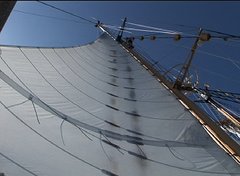After 1400 nm of sailing south from Hawaii at an average speed of approximately 6.5 knots- in seas that ranged between Beaufort 4 and 7 for most of the trip we are finally here at the Marine Protected Area known as Palmyra Atoll. Our Transect oceanography work is now complete with 6 project teams collecting oceanographic data daily that ranged from measuring pH, Chlorophyll, collecting and sequencing eDNA samples, to measuring the relationship of the depth of the oxygen minimum and deep scattering layer- to measuring the biomass captured in our meter net tows.
The squalls of the inter-tropical convergence parted ways today and full sunshine greeted us as the ship entered the Palmyra channel with emerald colored waters that have a gorgeous blue color when the sun hits the shallows- ocean is contrasted by the deep greens of the vegetation of this tropical paradise. Hundreds of Masked Boobys flew in to greet us and alighted on our rigging as we motored through the narrow channel with mantas swimming beneath us. Students looked in awe as we entered the west Lagoon and with a local escort we set our anchor for the first portion of our stay.
Once secured, a briefing by our TNC and FWS hosts took
place, and then two sets of Stanford
teams set off in the ship's zodiacs to explore the reef to conduct the first
set of coral reef fish transects on the terrace near Penguin spit. The
objective today was to begin re-examining the status of the reef as discerned
by our Stanford@SEA 2003 class, a project led
by former student Charlotte Stevenson. This year a team with Courtney
and Lilah McKormick along with additional students Anna, Regina and Jess are
surveying the same areas to see how they have changed.
In addition Postdoctoral associate Camille Pagniello and her acoustic team are "listening to the reef the next few days" to measure the fish sounds- a distinct way to assess the reef health. Finally our Manta Team has begun their oceanographic survey late this afternoon - sampling the Manta habitats using the 2.1 million acoustic detections and satellite tagging data we have collected with our Colleagues previously as a guide on where to go.
Remaining students are enjoying some well needed R & R at the Palmyra Swimming hole, and having guided tours of the bird habitats and landscape that makes this unique refuge a delightful place to visit.
From Palmyra,
Barbara Block
Prothro Professor of Marine Science





It's been great reading about all your adventures...hope all is well on the boat and that you are all having the experience of a life time...hey Camille you better teach Barb your last name...lol
ReplyDelete